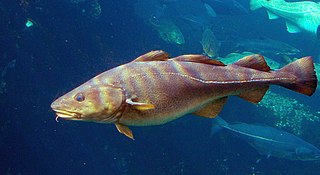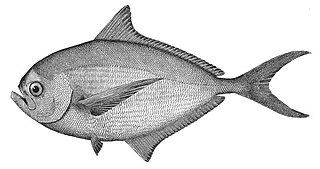
Cyprinidae is a family of freshwater fish commonly called the carp or minnow family, including the carps, the true minnows, and their relatives the barbs and barbels, among others. Cyprinidae is the largest and most diverse fish family, and the largest vertebrate animal family overall, with about 3,000 species; only 1,270 of these remain extant, divided into about 200 valid genera. Cyprinids range from about 12 mm (0.5 in) in size to the 3 m (9.8 ft) giant barb. By genus and species count, the family makes up more than two-thirds of the ostariophysian order Cypriniformes. The family name is derived from the Greek word kyprînos.

Tetraodontiformes, also known as the Plectognathi, is an order of ray-finned fishes which includes the pufferfishes and related taxa. This order has been classified as a suborder of the order Perciformes, although recent studies have found that it, as the Tetraodontoidei, is a sister taxon to the anglerfish order Lophiiformes, called Lophiodei, and have placed both taxa within the Acanthuriformes. The Tetraodontiformes are represented by 10 extant families and at around 430 species overall. The majority of the species within this order are marine but a few may be found in freshwater. They are found throughout the world.

Cod is the common name for the demersal fish genus Gadus, belonging to the family Gadidae. Cod is also used as part of the common name for a number of other fish species, and one species that belongs to genus Gadus is commonly not called cod.

Herring are various species of forage fish, mostly belonging to the family Clupeidae.
The wolf herrings are a family (Chirocentridae) of two marine species of ray-finned fish related to the herrings.

Osteoglossiformes is a relatively primitive order of ray-finned fish that contains two sub-orders, the Osteoglossoidei and the Notopteroidei. All of at least 245 living species inhabit freshwater. They are found in South America, Africa, Australia and southern Asia, having first evolved in Gondwana before that continent broke up. In 2008, several new species of marine osteoglossiforms were described from the Danish Eocene Fur Formation, dramatically increasing the diversity of this group. This implies that the Osteoglossomorpha is not a primary freshwater fish group with the osteoglossiforms having a typical Gondwana distribution.

Pomfrets are scombriform fish belonging to the family Bramidae. The family currently includes 20 species across seven genera. Several species are important food sources for humans, especially Brama brama in South Asia. The earlier form of the pomfret's name was "pamflet", a word which probably ultimately comes from Portuguese pampo, referring to various fish such as the blue butterfish. The fish meat is white in color.

Sprat is the common name applied to a group of forage fish belonging to the genus Sprattus in the family Clupeidae. The term also is applied to a number of other small sprat-like forage fish. Like most forage fishes, sprats are highly active, small, oily fish. They travel in large schools with other fish and swim continuously throughout the day.

Echinorhinus is the only extant genus in the family Echinorhinidae.

The onefin catshark is a species of shark belonging to the family Pentanchidae, the deepwater catsharks. It is the only member of its genus, Pentanchus. It is known from two specimens collected from the Tablas Strait and Mindanao Sea off the Philippines in the Western Central Pacific. It is classified as harmless to humans and of least concern to the IUCN redlist.

The narrowmouthed catshark is a coloured catshark beloning to the family Atelomycteridae, found from central Chile around the Straits of Magellan, to Argentina between latitudes 23° S and 56° S, at depths down to about 180 m (600 ft) in the Atlantic Ocean and about 360 m (1,200 ft) in the Pacific. It can grow to a length of up to 70 cm (28 in). The reproduction of this catshark is oviparous.

Eels are ray-finned fish belonging to the order Anguilliformes, which consists of four suborders, 20 families, 164 genera, and about 1000 species. Eels undergo considerable development from the early larval stage to the eventual adult stage and are usually predators.

An anchovy is a small, common forage fish of the family Engraulidae. Most species are found in marine waters, but several will enter brackish water, and some in South America are restricted to fresh water.
Rectoris is a genus of cyprinid fish found in China and Vietnam.

The Alosidae, or the shads, are a family of clupeiform fishes. The family currently comprises four genera worldwide, and about 32 species.
Rectoris longibarbus is a species of freshwater ray-finned fish belonging to the family Cyprinidae, the family which includes the carps, barbs. minnows and related fishes. This species is known only from its type locality, a temporary spring emerging from a karst formation which dries up outside of the rainy season in Jingxi County, Guangxi. Rectoris posehensis, Paranemachilus jinxiensis, Prolixicheilus longisulcus and Cophecheilus bamen were also found in the spring. The area around the spring has been subjected to earthquakes and has been heavily mined, surveys conducted for this species at its type locality have not found any more. The International Union for Conservation of Nature has classified it as Critically Endangered.
Rectoris longifinus is a species of freshwater ray-finned fish belonging to the family Cyprinidae, the family which includes the carps, barbs. minnows and related fishes. This species is endemic to Yunnan in China. This species was fisrt formally described) in 2002 from Zhoxi in Shilin County and said to be similar to R. posehensis, however, other authors consider that this species is unlikely to be a member of the genus Rectoris and that it is generic placement awaits further study.
Rectoris luxiensis is a species of freshwater ray-finned fish belonging to the family Cyprinidae, the family which includes the carps, barbs. minnows and related fishes. This species is endemic to China where it is found in the Yuan Jiang in Hunan, Qing Jiang in Hubei Province) and the Daninghe River in Sichuan. One study found that there were no discernible differences between the specimens of this species and the types of R. mutabilis suggested that R. mutabilis is s senior synonym of R, luxiensis. Eschmeyer's Catalog of Fishes, however, recognises both these taxa as valid species.
Rectoris mutabilis is a species of freshwater ray-finned fish belonging to the family Cyprinidae, the family which includes the carps, barbs. minnows and related fishes. This species is endemic to Yunnan in China. This species is endemic to China in the drainage basin of the Yangtze in Guizhou, Hunan, Chongqing and Hubei. One study found that there were no discernible differences between the specimens of this species and R. luxiensis suggested that R. mutabilis is s senior synonym of R, luxiensis. Eschmeyer's Catalog of Fishes, however, recognises both these taxa as valid species.












